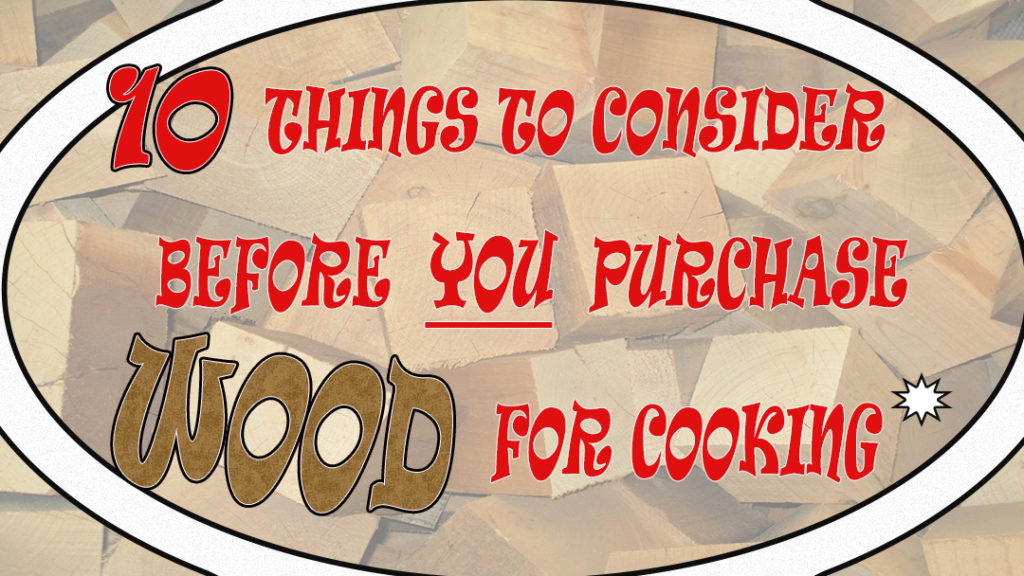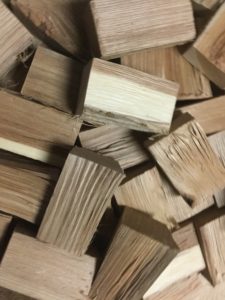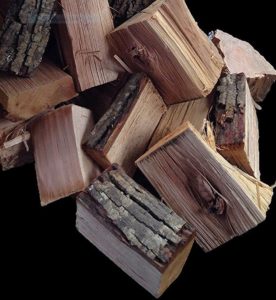
Smokinlicious® wood blocks are a pristine backdrop for the 10 things to consider when purchasing wood for cooking!!

Many of you who reside in the Southern and Western States have the advantage of being able to engage in wood-fired cooking pretty much whenever you want, regardless of the calendar. You may do so on an LP grill, a charcoal grill, charcoal/wood smoker, or electric grill or smoker. Those of us living in the North and to the East – though we could continue cooking outdoors all year – usually elect to restrict our outdoor cooking methods until temperatures climb above 55°F!
Soon, it will be an even playing field when it comes to enjoying the outdoors for all of us so what better way to get prepared than to start thinking about replenishing supplies for our outdoor living and cooking.
Today, I’m going to give you a guide on the top 10 things to consider when purchasing wood for cooking, grilling or smoking in general.
#1 Is the wood native to the USA?
If the wood comes from outside the United States, it doesn’t necessarily make it a bad choice but you do need to understand that importing wood products into the USA is highly regulated. Mostly, the wood needs to be certified that it has been treated in some way to ensure no insects are hitching a ride in! Remember, that treatment could be with chemicals or by heat only, so be sure you check the label. This product may turn out to only be ideal for hot temperature cooking like searing and grilling due to the dryness of the wood, or if chemicals were used, it shouldn’t be used at all.
#2 Is the wood 100% hardwood?
It is imperative that any wood you use to cook with, wood chips, wood chunks, logs or dust be only hardwood. Look for labeling that attest to the fact that only hardwood was used as some companies will use a mix of softwood and hardwood or include press woods.
#3 How does the company get the wood?
Many of the companies who supply wood chips for cooking have another manufacturing process that produces a scrap or waste product. Not Smokinlicious®! Often, those leftovers are used in this secondary business of BBQ woods, smoking woods, or cooking woods, to name a few of the labeling names. Check packaging for the source or origin location of the wood and if that company name matches the one on the front of the packaging label.
#4 Are you getting the wood named on the label?
This seems like a no brainer but honestly, wood is no different than olive oil or cheese. You may not be getting 100% of the wood species listed on the label just as we’re finding extra virgin olive oils may not be extra virgin or grated cheese isn’t 100% cheese! If you find packaging that simply states “hardwood” or “mixed hardwoods” then you don’t know what you’re getting. Be sure to read the entire label and check for a reference to 100% of a species.
#5 Is the brand name the actual manufacturer of the wood or just the distributor?
It is very common for brands to be in a business that they don’t participate in from a manufacturing point. Check the small print on the label to see if the manufacturer of the product is listed or if the label simply states who the product is distributed by. Distributors don’t have a lot of history on the product in the box or bag.
#6 Does the seller make claim to a certain cooking method for the wood?
This is key to ensuring you don’t end up with a disaster. If the packaging clearly states the product is for grilling, then don’t try to use it in your smoker or stove top smoking pan. Compatibility of a cooking wood to equipment should factor in the moisture level of the wood. Too dry, and it will just catch fire. Too wet and you won’t be able to grill with it.
#7 Are there any terms such as “naturally cured” or kiln dried on the label?
The terms generally mean that the wood has been air dried for an extended period, much like you do with firewood before using it in your fireplace, or the wood has been exposed to low temperature drying in an enclosed area. Either method means the wood will usually have a moisture level of 4-13% which will not make it ideal for hot smoking techniques. Again, these woods are best for high heat level cooking as dry wood produces a lot of heat. Woods with a moisture level ~20% are ideal for hot smoking.
#8 Does the wood have bark?
Bark is the protector of the tree and so it is like a sponge, absorbing anything that isn’t healthy to the tree. When bark-on wood is exposed to heat, you will get a lot of separation or weakness to the cell structure of the bark. This can loosen during exposure to heat and burn separately causing flare ups in temperature control, sparks, and leave a coating on your equipment. If you have an option, go bark-free!
#9 Does the packaging label reference cooking or merely say “firewood”?
If you planning on going camping and setting up an elevate cooking grate over the fire, or using a Dutch oven for cowboy-style of cooking, then I don’t have a problem with using split firewood for the cooking part. This is in the great outdoors where there is a lot of area to handle the smoke vapor. But if you are using any kind of equipment that has a contained firebox area, please use something other than firewood to cook with. You simply don’t know where the wood has been or what it may contain so cooking within a confined chamber is not the ideal. Firewood can have a lot of resin, sap, and spark.
#10 Does the brand sell the product by weight?
Wood is a commodity that has a lot of variance when it comes to weight due to differences in density, moisture level, and variety of the species. It is the reason why wood cannot be sold by weight legally. Look at the packaging and be sure there is a reference to cubic inches, cubic feet, liters, centimeters, etc. Anything but weight.
There you have it! A guide for your upcoming outdoor cooking season using a variety of cooking/grilling woods like wood chips, chunks, logs or dust. Take a bit of time to check the packaging and examine all the information on a website before making your decision. Most importantly ask yourself: Do I want to eat anything cooked over this?

Dr. Smoke- Before purchasing wood for cooking, it’s important to know the many factors!

More Related reading on purchasing wood for cooking:


